Abstract
The contemporary concerns regarding the provision of Basic Education in the Humanities, capable of preparing students for cognitive exercise as critical citizens and professionals who meet the demands of the 21st century, underpin the inquiry that guided this project: “How can the Teaching of History and Cultural Heritage in Basic Education operate significantly in the face of new demands in the relationship between human societies and digital technologies?” It is understood that enabling technologies 4.0 also encompass Artificial Intelligence (AI) and Robotics (used in industry, but also in education), and their incorporation into teaching and learning for new generations is important. The BNCC (2017) emphasizes the importance of using material objects to assist teachers and students in questioning the meaning of things in the world, stimulating the production of historical knowledge in the school environment. Understanding this practice as an action in which teachers and students can play the role of agents in the teaching and learning process, both assuming a “historical attitude” towards the proposed contents. Therefore, the aim was to present the results of the research and technological developments carried out during the “SayHist – AI and Robotics in Museums of Sergipe” project, between 2022 and 2023, aiming to create a mini robot connected to an application capable of presenting exhibitions from two museums in Sergipe (Museum of Sergipe History – MUHSE) through audio and video, with speakers and a micro-projector.
1. Introduction
In the disciplinary field of History, the contemporary chronology marking the evolution of technology usage with a strong impact on socio-economic, cultural, and political relations of human life began in the 18th century with the First Industrial Revolution, where the production of artisanal goods was replaced on a large-scale using factory machines and steam-powered labor. The second change occurred in 1870 (19th century) when electricity altered production methods, establishing assembly lines and task specialization, while also favoring social interactions through nighttime illumination. Days became longer, increasing their utility. The so-called third industrial revolution, or “Digital Revolution” of the 20th century, paved the way for the development and popularization of computers, the internet, and mobile telephony [1].
However, the first two decades of the 21st century brought what has conventionally been termed the “Fourth Industrial Revolution”, which has moved from the realms of science fiction and theory to occupy significant space in everyday life [1]. The integration between artificial and biological systems can already be seen in microchips implanted in humans containing banking data and allowing for contactless payment with a simple wrist gesture towards machines.
The advancement in algorithm sophistication, software and hardware development strengthening machine learning, communication between digital devices, and their functionalities in environments through sensors characterizing the Internet of Things (IoT), namely, the extension of internet reach to other physical objects, is being utilized in various domains. These include domestic consumption (smart TVs, smart bulbs, virtual assistants, temperature monitors), commercial applications (fleet management through telematics in transportation, surgeries, and disease prevention in the medical field [smartwatch monitors], accident prediction in insurance), industrial sectors (automobile manufacturing, petrochemicals, mining, agricultural machinery), and infrastructure (electric, hydraulic, and urban construction sectors) [2].
In the Brazilian cultural sector, several museums already operate with the Internet of Things (IoT), as exemplified by the JK Memorial in Brasília, DF (Federal District), where the hologram of President Juscelino Kubitschek is activated by sensors on the doors as visitors enter one of the exhibition rooms, welcoming them and presenting the history of Brasília's construction. At the Jewish Memorial in São Paulo, in the former synagogue, screens displaying videos of Jewish culture related to local history automatically turn on when a user approaches. In the Museum of Sergipe People in Aracaju, Sergipe, in the “Our Stories” room with dim lighting, sensors cause the display niches to light up as visitors approach, accompanied by a soundtrack of Sergipe music.
Such digital technological advancements have led to the definition of “enabling technologies”, playing a crucial role in the process of “business digitization” related to the Fourth Industrial Revolution and what is termed “Industry 4.0”.
The technologies of big data, cloud computing, and the Internet of Things (IoT) enable the capture and storage of data for use in simulations, interpretation with artificial intelligence (AI), and system integration. Among the results of these interactions are 3D printing or additive manufacturing, the operation of machines and autonomous systems, and increased integration in actions between humans and machines [3].
The enabling technologies 4.0 still include Artificial Intelligence (AI) and Robotics, common in industry but also in education. AI is defined as “the application of advanced analysis and logic-based techniques, including machine learning, to interpret events, analyze trends and system behaviors, support and automate decisions, and perform actions”, while Robotics (usually associated with AI) are understood as “devices that act largely or partially autonomously, interact physically with people or their environment, and are capable of modifying their behavior based on sensor data” [4].
Despite all the concerns about the dangers that this popularization of the field of AI raises in current societies, it is crucial to bear in mind that “the smarter and more powerful machines become, the more important it is that their goals are aligned with ours”. Therefore, humanity's greatest challenge is to understand itself, its desires, its decisions, its worldview in the present and for the future. It is our humanity that will define the behavior of machines, so the problems posed at this moment are: 1. Making AI learn our goals; 2. Making AI adopt our goals; and 3. Making AI retain our goals [5].
In this sense, the education of current and future generations, especially in the field of Humanities and Social Sciences, which stems from the fundamental inquiries of Philosophy, recalls History and its relation to different temporalities, reflects Sociology and Anthropology of individual and social behaviors, is a fundamental part of this process of ethical and responsible humanization of intelligent machines and their functionalities for the common good. It is therefore pertinent to inquire: “What kind of scientific-cultural education will contribute to citizens' decision-making?”, “How can the Teaching of History and Cultural Heritage in Basic Education significantly address new demands in the relationship between human societies and digital technologies?”, “How can pedagogical resources combining Programming Language, Robotics, and AI integrate formal and informal education, school education, and museum education in Sergipe and other geographies (through replication) based on education about museums in Sergipe?”.
In the field of Basic Education, the National Common Curricular Base (BNCC) has listed among its general competencies: understanding, using, and creating digital information and communication technologies critically, meaningfully, reflectively, and ethically in various social practices (including school ones) to communicate, access, and disseminate information, produce knowledge, solve problems, and exercise protagonism and authorship in personal and collective life (Brazil, 2017, p. 9) [6]. Thus, History teachers will be compelled not only to handle but also to use inventiveness in creating new technologies.
According to research by Anwar [7], the integration of robotics in an educational environment can spark interest in STEM (Science, Technology, Engineering, and Mathematics) topics and enable deeper student engagement with complex concepts.
Thus, this article intends to present the results of the research and technological developments carried out during the “SayHist – AI and Robotics in Sergipe Museums” project, between 2022 and 2023, aiming to create a mini-robot, connected to an application, capable of presenting exhibitions from two museums in Sergipe (Museum of Sergipe People and Sergipe Historical Museum) through audio and video, with speakers and a micro-projector.
The use of this AI robot is directed towards actions of Heritage Education and Museum Education carried out with a work plan focused on the Sergipe Historical Museum, both with children and adolescents, and for the training/updating in AI and robotics knowledge with History teachers of Basic Education.
A robotic car with responsive artificial intelligence can enhance engagement and knowledge retention in museums by serving as an interactive mediator between exhibits and visitors. Equipped with sensors for autonomous navigation, audio modules, and a natural language processing (NLP) interface, the robot provides explanations, answers questions, and suggests educational activities tailored to the audience's profile. This solution combines playful learning with technology, making exhibit content more accessible and appealing to children and teenagers. Its effectiveness can be evaluated through metrics such as interaction time, the number of questions answered, and knowledge retention assessed before and after experience.
2. Robotics, education, and museums
Robotics operates in the design and construction of physical devices (hardware) for the purpose of developing tasks performed by humans, requiring intelligent systems of command and action. To achieve this, it incorporates concepts of kinematics, automation, hydraulics, pneumatics, computer science, and artificial intelligence capable of providing “movement” to the robot [8].
Anwar [7] stated that while some publications from studies and applications demonstrate the role of educational robotics in increasing student interest and engagement, there is still limited evidence available in the results to reach a conclusion about the relative effectiveness of educational robots on student learning outcomes and professional skills such as communication and collaboration. Additionally, most studies lack details on the implementation of educational robotics within and outside school environments.
This reveals that there is a gap that research and practices in the field of educational robotics still need to fill. Regarding the Brazilian context and the Teaching of History and Cultural Heritage in Basic Education, the BNCC[6] points out, among the general and specific competencies, in addition to the one mentioned earlier concerning “understanding, using, and creating digital technologies”, others that emphasize the convergence or specificities of the culture/technology relationship linked to the development of critical-reflexive thinking, pragmatic training for the contemporary job market, citizenship exercise, ethics, and promotion of diversity.
The BNCC [6] emphasizes the importance of using material objects to assist teachers and students in questioning the meaning of things in the world, stimulating the production of historical knowledge in the school environment. Understanding this practice as an action in which teachers and students can play the role of agents in the teaching and learning process, both assume a “historical attitude” towards the proposed contents, within a process suitable for Elementary Education.
Typically, the Teaching of History and Cultural Heritage is delivered through books, booklets, videos, slides with photographs, technical visits to spaces of material and/or immaterial cultural heritage. More recently, teachers have started to utilize digital resources such as Google Earth and Google Art Project for virtual visits to various locations. This allows cultural heritage to be integrated into the curricular content of the History discipline, rather than being limited to an isolated project unrelated to other studies throughout the academic year.
But educational robotics still has its access linked to the STEM and STEAM methodologies, the latter incorporating Arts into the others already mentioned. However, these methodologies are still rarely used by History teachers, as well as robotics, which requires knowledge of microelectronics and programming languages.
In museum institutions, the use of robotics is more common in some science and technology museums, such as the Catavento Museum in São Paulo or the MIT Museum at the Massachusetts Institute of Technology (Cambridge, Massachusetts) with exhibitions on robotics (Fig. 1), and also the Center for Cultural Heritage Technology at the IIT - Italian Institute of Technology (Marghera, Venice), which has developed humanoid robots for some educational activities (Fig. 2).
Fig. 1Exhibition “Robots and Beyond” (MIT Museum’s)
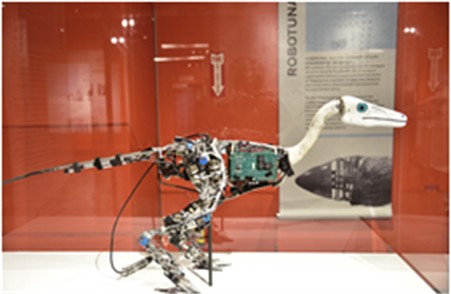
Fig. 2Humanoid Robot iCub (IIT)
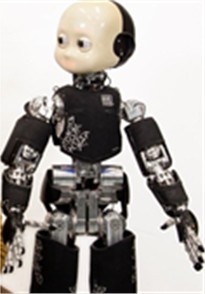
The managers and researchers at IIT argue that in the dawn of the 21st century, Italy should build up its technological and educational ecosystem, both public and private, preparing an appropriate ethical and regulatory framework to be an active part of the ongoing digital revolution, thus being able to compete with other players at the European and global levels. Therefore, it can offer a new vision of this technological approach, combining human needs with those of the economy, integrated with the manufacturing, education, and cultural heritage sectors [9].
In 2019, a plan was announced for the construction of the Robotics Science Museum in Seoul, the capital of South Korea, with a project by the Turkish firm Melike Altınışık Architects - MAA, from Istanbul, Turkey. Its construction began in 2021, and its opening is scheduled for visitation by the end of 2023. The space will be characterized by cutting-edge technology at its core, with the museum highlighting advancements in robotics throughout all stages of the process, not limited to its exhibitions. The main highlight in this regard is that it will even be built by robots [10].
This new perspective of integration “enabling technology + museum” in the 21st century stems from the development of understanding, in “Science Museums”, that “the communication between visitors and science is mediated by greater interactivity with devices that highlight the subject’s action in learning” [11].
Regarding AI applied to Education, the project “Dynamic Mapping of Artificial Intelligence (AI) in Education”, developed by the team of the International Observatory on the Societal Impacts of AI and Digital Technology (OBVIA) at Université Laval in Québec, in partnership with the Université de Montréal, the Université du Québec à Trois-Rivières, and Collège Ahuntsic, has been mapping the uses of Artificial Intelligence in Education on a global scale since before the Covid-19 pandemic.
The main objectives of OBVIA are: To identify and present tools and projects based on the use of artificial intelligence for educational purposes, whether at the local, regional, provincial, national, or even international level. Among its research, the part of AI applied to Robotics, Speech Recognition, Natural Language Processing, and Visual Recognition (Fig. 3) was of interest to this work.
Fig. 3Mapping areas diagram by OBVIA adapted to SayHist robot interests
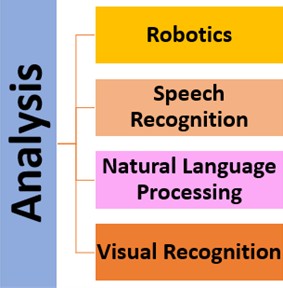
The expected outcomes of the project development were: 1) an App developed in Programming Language for AI; 2) A mini-robot using applied educational robotics; 3) The use of sensors to enable IoT between the App and the mini-robot. The development of the proposal to integrate the first hybrid prototypes (software and hardware) of the SayHist robot used the data locus of the Sergipe Historical Museum (MUHSE) in the city of São Cristóvão (Figs. 4 and 5).
Located in São Francisco Square – a UNESCO World Heritage Site since 2010 – the space that housed the former Provincial Palace between the 18th and 19th centuries and is now the Sergipe Historical Museum established in 1960, features a building whose architectural lines highlight the baroque style. It was listed as a state-protected property for its value and preservation in September 2003. Its rich and diverse collection was gathered by brothers Junot Silveira and Jenner Augusto, who served as the first curators of the Sergipe cultural institution [12].
It features “[…] furnishings from the 19th and 20th centuries; various artistic paintings; busts of Sergipean personalities; collections of coins, medals, ceramics, antique telephones; as well as rare objects and photos of cangaceiro characters and much more” [12].
Approved by the International Council of Museums (ICOM) on August 24, 2022, in Prague, the capital of the Czech Republic, the new definition of museums, the result of virtual and face-to-face dialogical meetings of various Museology professionals and multidisciplinary fields, sought to incorporate terms and concepts related to contemporary challenges, such as sustainability, diversity, community, and inclusion.
However, the use of digital technologies, which was crucial for the survival of many museum institutions during the pandemic and the social isolation that closed their doors, and which needed to digitize their collections, physical spaces, and educational activities to varying degrees of sophistication, did not appear in the new conceptualization. The justification was not to exclude institutions without financial capital for this adoption. However, due to its invisibility, it seemed to endorse a “delay” that, on the contrary, should be challenged, and its updating demanded in the processes of transformation of contemporary demands. For not discussing digital technologies in museums and museum education does not make them disappear, but rather deepens the gap between different institutional realities and institutional and geographical asymmetries.
Paradoxically, in 2019, in the USA, museums (The museums that use Pepper are: 1. The National Museum of African American History and Culture, 2. The Hirshhorn Museum and Sculpture Garden, and 3. The National Museum of African Art, in addition to the Smithsonian Castle [13]) of the Smithsonian Institution in Washington installed humanoid robots, called Pepper, to interact with visitors, answering questions, telling stories, using voice, gestures, and a touch screen. They also dance, play, and pose for selfies with users [13].
Affiliated companies such as SoftBank Robotics, based in Japan but with branches in the USA, China, Hong Kong, Singapore, Australia, and Aldebaran, a member of the United Robotics Group in Germany, have developed humanoid robots and robotic platforms for various applications and were responsible for supplying robots to the Smithsonian. With highly sophisticated technology and multimillion-dollar investments, their production line introduced the NAO – a robot for Primary Education using AI (Fig. 4); Pepper, which has been used in museum hospitality, commerce, and other institutions (Fig. 5), as well as Sawyer, born at MIT, a socio-collaborative robot used in manufacturing (Fig. 6) [14].
Fig. 4Humanoid robots NAO
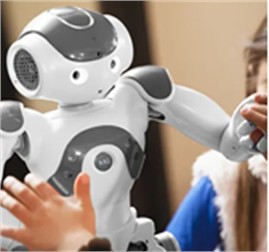
Fig. 5Humanoid robots Pepper
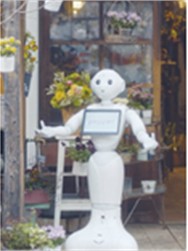
Fig. 6Humanoid robots Sawyer
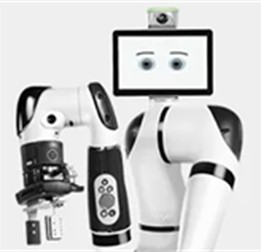
One of the most intriguing innovations in the field of service robots lies in the development of humanoid robots built to resemble humans, replicating human facial characteristics and/or musculoskeletal morphology like humans, such as the face, arms, and legs [15].
Although our goals are extremely modest, given the scarce resources allocated to a Program Scholarship in Technological Development and Innovation (PIBITI) project, we opted for the development of a social technology with low-cost and easy-to-handle materials, with the possibility of being replicated in other museums across the country. Thus, SayHist can become a pedagogical resource of public utility and encourage the adoption of robotics as a possibility for learning History and Cultural Heritage in museum institutions.
Cultural heritage comprises a set of assets with significance for a community that must be identifiable and transmissible, promoting self-referencing within a given space and people, recognizing them as “their own”, allied with values that articulate the legacy of the past, organized in the present, towards the proposal of a future, adapting to the mutations of time and its continuities. Framed by normative devices as plural, diverse, multiethnic objects, places, and practices, which unfold through social relations, they cultivate affinities by aggregating emotions and knowledge experienced in this context [16].
We understand “museum education” as educational actions designed and implemented in museums, involving multidisciplinary educators and researchers, attentive to the changes of times and societies to align institutional needs with demands beyond cultural space. It dates to 1927, but in 2017 its national policy was established by the IBRAM – Brazilian Institute of Museums [17].
3. The academic literature exploring robots in museums
The search for digital technology solutions in museums has been a recurring trend globally, both before and after the COVID-19 pandemic, which forced many institutions to close their doors and adapt to the new informational era. The Palace Museum in Beijing, Hong Kong (China), despite its deep-rooted tradition, serves as an example of blending tradition with modernity while preserving its cultural identity [18].
The text “The Construction of the Museum Audience Data System Based on Big Data Technology” by Chang et al. (2024) highlights the gradual implementation of digital resources on media platforms for computers and mobile devices, establishing a communication model for digital services based on an integrated cross-media platform. However, in response to new demands, the research proposed a digital upgrade plan for museum cultural services and technology integration through a unified digital platform and an “online + offline” service model [18].
This approach aims to strengthen the connection and circulation between digital cultural services and the public, enhancing user-oriented services through technological means. It involves developing practices to facilitate user access to various services and information, thereby increasing public engagement with museums [18].
Recent research in the field of robotics applied to museums has focused on studying user experiences to present projections for the future of robot guides. For instance, the article “Robot Turist Rehberi ile Gezmek Nasıl Bir Şey? RoBoHoN’a İlişkin Kullanıcı Deneyimi Üzerine Bir Söylem Analizi” investigates the case of the RoBoHoN guide robot, which provides services in Japan, and the experience of presenter Roger Ditter, who participated in a tour in Kyoto as a user of this service [19].
The research results revealed that RoBoHoN has characteristics that negatively affect the user experience, such as high cost, non-ergonomic design, poor communication with users, limited content in information delivery, and low performance in various conditions. Therefore, Roger Ditter does not recommend the RoBoHoN guide robot for people visiting a destination for the first time, and his discourse regarding the user experience is largely constructed with negative components [19].
The study's conclusions highlighted that the inability of robot guides to provide information beyond pre-programmed and preloaded content is a limitation in robotic guide services at least for RoBoHoN. However, thanks to the presence of the robotic guide, the tourist knows where, when, and why to look. Improvements in features such as voice recognition, human interaction, and narration with personalized content could enable robotic guide services to become efficient and effective in outdoor tours at destinations, making them more widespread [19].
It is believed that in the future, robotic guide services may become an alternative preferred only by those who desire them. Nowadays, there are tourists who opt for audio guide services or mobile guide applications instead of joining guided tours. However, many people still participate in traditional guided tours. Innovations in robotic guide technology, changes in tourists’ habits, the status of human labor in tour guiding, and global developments in tourism will determine the scope, reach, popularity, and employment conditions of human guides versus robotic guide services in the future [19].
The study argues that the expertise of human tour guides can be utilized in developing robotic guide technologies. Thus, advancements in robotic guide services may transform the roles of human guides rather than displacing them from the field. The contribution of human guides to the development of robotic guide technologies could not only enhance the relevant technology but also create new employment opportunities for human guides. This approach does not envision robotics as replacing human labor in museums and cultural heritage spaces, but rather as fostering a human/machine partnership [19].
The text “Tour Guide Robot: A 5G-Enabled Robot Museum Guide” by Rosa et al. (2024) addresses the development and deployment of a tour guide robot as part of the 5G-TOURS EU research project, aimed at creating 5G-enabled applications across various use cases. The goal is to develop an autonomous robotic application where intelligence is offloaded to a remote machine via a 5G network, thereby reducing the computational load on the robot itself [20].
The application utilizes components extensively studied in robotics, such as localization, mapping, planning, and interaction. The work introduces a recent solution for engaging visitors in museum tours, referred to as “social robots”. Social robots are autonomous, embodied agents that communicate and interact with humans on a social and emotional level. They represent an emerging field of research focused on maintaining the illusion of interacting with a human being [20].
The study argues that the high bandwidth and low latency provided by 5G networks are particularly suited for implementing robotic applications in the field, especially with low-cost humanoid robots. These robots must ensure safe and consistent operation over extended periods [20].
The experiment conducted in Turin (Italy) demonstrated the advantages of 5G network performance compared to the previous mobile generation (4G). However, the solution implemented for this project was based on NSA architecture and did not adopt Slice management, which could ensure consistent bandwidth [20].
The mobile coverage of the area was designed to meet experimental requirements and explore the challenges of field deployment, including the most critical circumstances where the robot ceases to operate. This challenge can also be addressed from the perspective of autonomous navigation through sliding autonomy approaches, transitioning from a full navigation configuration to a fallback navigation configuration executed locally on the robot. This fallback mode, with limited sensing, can run on the robot’s constrained onboard hardware. In essence, the experiment highlighted both advances and limitations [20].
Human-robot interfaces encourage cognitive, affective, and behavioral actions in anthropomorphic AISRs (Artificially Intelligent Social Robots) that resemble human interfaces. Acceptance and use of anthropomorphic AISRs appear to go beyond aspects of appearance and cognitive intelligence, encompassing social, emotional, moral, and empathetic traits to foster better customer engagement and acceptance. The physical appearance of anthropomorphic AISRs functions as human-like attributes that influence user interactions [21].
This perspective is explored in the study “Embracing Digital Companions: Unveiling Customer Engagement with Anthropomorphic AI Service Robots in Cross-Cultural Context”, which offers a contemporary understanding of AISRs in frontline services. The research provides a comprehensive view of anthropomorphic AISRs by examining the combined effects of appearance, cognitive intelligence, emotionality, morality, and social presence on user engagement and usage intention. It highlights empathy as a key characteristic of anthropomorphic AISRs, moderating the relationship between their attributes and customer engagement [21].
The study introduces a fresh perspective on AISRs with empathetic traits, aiming to enhance user response. The proposed model was empirically tested in a cross-cultural context: Study 1 was conducted in a low-context culture (Canada), while Study 2 was replicated in a high-context culture (India). As a result, the research offers valuable insights into optimizing interface design and aligning AISR anthropomorphism with customer responses across diverse cultural settings [21].
We observe an increase in research and applications of robotics in museums and cultural heritage areas, whether as robotic guides, user reception systems, or tools aimed at enhancing autonomy and the use of digital technologies to strengthen the human-machine relationship, which is becoming more prominent in the 21st century. Despite the challenges and issues encountered, there is a focus on the pursuit of adaptable solutions, the use of 5G technologies, designs better suited to the context of localities and populations, and the fostering of emotional connections in humanoid robotic design, among other possibilities. Whether in North America, Asia, or Europe, these processes are evolving, highlighting the need for Latin America, particularly Brazil, to engage in both theoretical research to learn and develop cost-effective strategies, as well as to move into laboratories to create applications that offer prototypes and reflective experiences.
4. Methodology and technical description
The work involves the development of a mini-robot connected to an AI-instructed application, which will answer questions about the Museu Histórico de Sergipe (MUHSE) in São Cristóvão, the local cultural heritage, and its exhibitions, equipped with speakers and a holography micro-projector. Thus, the methodology was divided into two related axes: 1. Experimental (Research and Study) and 2. Prototyping (Creation and Application).
For the experimental research axis, aiming to test the hypotheses of technological development research as data collection and analysis were carried out, the following principles were followed: 1. Cause-and-effect idea; 2. Hypotheses and tests; 3. Treatments; and 4. Execution/output.
In the Prototyping axis, the focus was on developing hybrid technological resources (software and hardware) to validate requirements, based on conditions assessment, experimentation, validation, and improvement, guided by 1. Prototyping Plan; 2. General Definition; 3. Executable Prototype; and 4. Evaluation Report.
– Experimental Axis. SayHist – Experimentation Processes. Cause-and-effect idea; 2. Hypotheses and tests; 3. Treatments; and 4. Execution/output.
In the implementation of a robotic methodology for teaching cultural heritage in museums (Fig. 7), the cause-and-effect relationship centers around using a robot to increase visitor engagement and knowledge retention. The robot's ability to navigate autonomously, recognize voice commands, and provide relevant educational responses through audio is expected to enhance the learning experience. The hypothesis is that this interactive system will make learning more dynamic, and testing it involves developing prototypes with sensors for navigation, voice recognition, and audio modules. Success is measured by response quality, engagement time, and clarity of audio in real museum environments.
Treatments involve iterative improvements to the robot’s hardware and software, such as refining navigation algorithms, enhancing voice recognition accuracy, and optimizing communication with AI models like GPT or Dialog flow. Execution involves deploying the robot in the museum, where it interacts with visitors in real-time, navigating the space and answering questions about exhibits. The output is a fully functional robot that engages visitors while promoting cultural learning. The system's effectiveness is evaluated through metrics like interaction data, visitor feedback, and knowledge retention surveys post-interaction.
Fig. 7Design thinking (ideation)
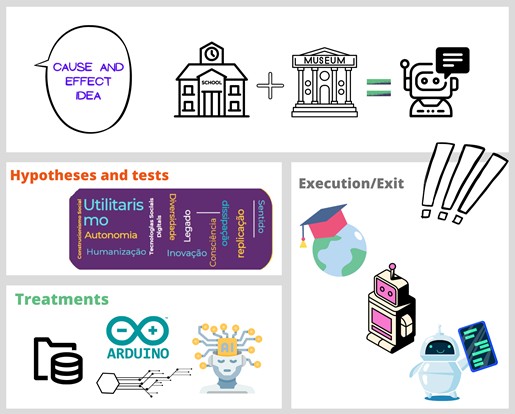
– Prototyping Axis. SayHist – Expected Reference Architecture. 1. Human voice command, 2. Electronic reception, 3. Voice requirement (input), 4. Data storage/Language processing, 5. Voice response (output).
In the development of a virtual assistant like Alexa, the relationship between the components (Fig. 8) begins with the human voice command, which is the user's initial interaction with the system. The electronic reception of this command is done by a microphone integrated into the device, capturing the audio in real-time and converting the analog signal into digital. The voice command is then processed as an input, which needs to be analyzed and understood by the system based on speech recognition models. This audio is sent to a server or local processing unit, where natural language processing (NLP) occurs using machine learning algorithms, such as neural networks, to interpret and extract the user's intent.
Next, data storage and language processing come into play, where the system accesses a database or uses NLP APIs to map the user's request to an appropriate response. The processing involves converting the identified intent into an action or answer, often based on stored information or connected to external systems, such as web services. Finally, the voice response (output) is generated through speech synthesis, where the system converts the response from text back into audio. This response is then emitted by the device, providing a smooth interaction with the user, using technologies like TTS (Text-to-Speech) to ensure the answer is clear and natural.
The proposal follows the line of implementing data about exhibitions in the focused museum (MUHSE) in the application, and through holography, it will be possible to go through the exhibition, with sounds, immersive narrations, presenting photos, and illustrations of the exhibition.
Fig. 8Functional design (projection)
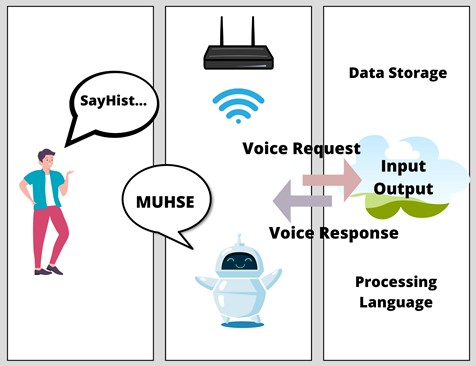
Table 1Questions and answers MUHSE – SayHist robot
Questions | Answers |
1. What is MUSHE? | It is the Sergipe Historical Museum |
2. When was the Sergipe Historical Museum created? | It was created in 1960 |
3. When was MUSHE registered as cultural heritage? | It was registered in 2003 |
4. Where is MUSHE located? | In São Cristóvão, Sergipe, at São Francisco Square |
5. What is the importance of São Francisco Square? | It is a cultural heritage of humanity recognized by UNESCO since 2010 |
6. Which famous painting is in MUSHE? | The painting “Peri and Ceci” by Horácio Hora |
7. What is the painting “Peri and Ceci” by Horácio Hora? | A painting from 1882, inspired by the book “O Guarani” by José de Alencar |
8. Who was Horácio Hora? | He was a painter born in the municipality of Laranjeiras, Sergipe |
9. Which UNESCO document is on display at MUSHE? | The title of World Heritage given by UNESCO to São Francisco Square |
10. Which collections does MUSHE have in its exhibition? | Coins, furniture, paintings, cannons, etc. |
11. Which intangible heritage is taught in the MUSHE exhibition? | The folk group “Caceteiras de Mestre Rindú” and the sweets “Queijadinha” and “Bricelet” |
12. Which part of history does the MUSHE exhibition inform about? | History of Colonial and Imperial Brazil and the History of Sergipe |
5. Results and discussion
To create the prompts (commands) of the required Programming Language in language processing with questions and answers to feed the chatbot, the following protocol was developed, i.e., “a convention that controls and enables a connection, communication, data transfer between two computational systems” [22].
The storage of questions and answers in a multifaceted and dynamic database also allows for new information about the MUSHE to be added over time to assist in the Teaching of History and Cultural Heritage in Sergipe, as well as its use in museum education by cultural agents of the MUHSE. This part comprised both the Experimental Axis (Research/Study) and the Prototyping Axis (Creation and Application) with the Programming Language in the creation of the database and the development of a responsive chatbot with AI.
In the specific part of Prototyping with robotics, the Arduino programming language was used for robotics related to the assembly of Arduino kits, testing with chatbot and verification of sound/audio on smartphones. Movement with motor. First prototype (SayHist 1.0).
From the kits, it was possible to assemble a first prototype with movement (SayHist 1.0) and a responsive speaker box attached to a metal shaft with 4 wheels driven by an electric motor (Fig. 9).
Fig. 9Prototype SayHist 1.0
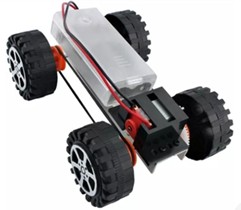
After conducting readings on voice recognition and natural language processing; machine learning; image recognition; holography, we moved on to the “Study and Application” with the assembly of Arduino kits; testing with AI chatbot; verification of sound/audio in attached speakers; holographic projection of 4 scenarios of the MUHSE (building, exhibition room, museum object, document of São Francisco Square as a World Heritage Site). Movement with motor and sensors.
Fig. 10Prototype SayHist 2.0
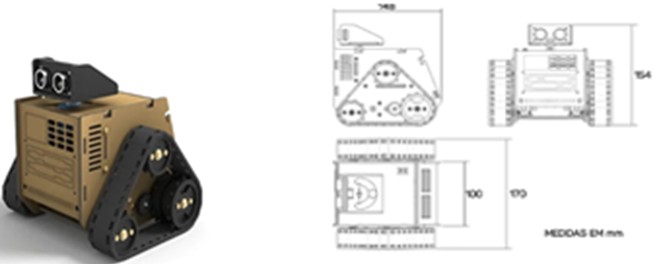
The construction of a robotic car using an Arduino kit, integrated with artificial intelligence, combines motion control, audio playback, and question-and-answer processing for interaction in educational environments like museums. The Arduino controls motors and sensors for autonomous navigation, while an audio module plays sounds, and a more advanced microprocessor (such as a Raspberry Pi) manages voice recognition and communication with AI APIs like GPT for intelligent responses about the museum’s collection. Integration is achieved through protocols such as HTTP or MQTT, enabling the robot to navigate and interact dynamically and educationally with visitors.
After the development of the second prototype (SayHist 2.0) (Fig. 10), the mixed logo of SayHist MUHSE (Fig. 11) was created, inspired by the colors of the flag of the municipality of São Cristóvão (green, yellow, blue, and white).
The mixed logo features the name SayHist, along with the map of São Cristóvão with a tourist marker, a seal representing the historic city, and a speaking robot with the acronym MUHSE, alongside the UFS logo, all against a green background representing the flora of Sergipe and the vegetation of São Cristóvão municipality.
For museum education, as well as for the design of the art containing the visual identity of SayHist MUHSE, they express not only the research conducted but also the application that combines tradition (History/Memory/Culture) with the demands of the present and future (Artificial Intelligence and Applied Robotics) in the development of hardware and software to promote the Teaching of History and Cultural Heritage according to the guidelines proposed by the BNCC.
Fig. 11Logo SayHist robot MUHSE
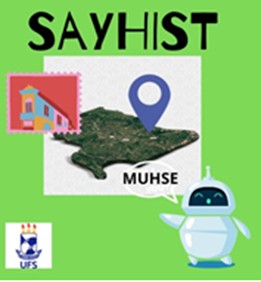
The proposal to develop a robotic virtual assistant, with voice interaction capabilities and artificial intelligence in museums, represents a significant innovation for museums in Sergipe, Brazil, and Latin America. Traditionally, museums have been spaces for passive learning, focusing on static exhibits and guided tours, where the public interacts with the content in a limited way. The introduction of interactive robots using natural language processing (NLP) and artificial intelligence not only transforms how information is presented but also democratizes access to knowledge, creating a personalized educational experience. The robot can answer questions in real-time, provide historical contexts tailored to the visitor’s profile, and even conduct playful activities, making learning more engaging and dynamic.
Moreover, this proposal positions Sergipe and, by extension, museums in Latin America at the forefront of technological innovation in the field of museum education. While museums around the world are starting to explore emerging technologies like artificial intelligence and robotics, the use of these tools in a Latin American cultural context is still in its early stages, creating a space for experimentation and regional leadership. The implementation of an educational robotics system combined with AI can transform how cultural heritage is shared and experienced, especially in areas with limited access to advanced technological resources, promoting digital inclusion and stimulating interest in cultural and scientific heritage in an interactive and accessible way for audiences of different age groups and educational levels.
6. Conclusions
The work was dedicated to the development of a cultural pedagogical resource capable of combining robotics, programming language, and artificial intelligence. After conducting research on the topic in information databases, practical work was initiated to create the database that feeds the question-and-answer relationship through interactive AI. The history of São Cristóvão, summarized in 12 questions related to the Historical Museum of Sergipe, São Francisco Square, and the material and immaterial heritage of the city, allows for a more active teaching approach that engages students, especially those with learning disorders (ASD, ADHD, Down syndrome, etc.).
With robotics kits and Arduino manipulation, it was possible to create two prototypes (SayHist 1.0 and SayHist 2.0) with mobility and materialization of sound and holographic image propositions with scenarios from exhibitions at MUSHE. The production of a Digital Handbook with tutorials in infographic format, allowing teachers in Basic Education to use SayHist in their classes, as well as museum educators, complements the pedagogical resources offered for scientific dissemination in History, Culture, and its Technologies.
This aligns with the BNCC’s objective for Basic Education to “Produce, evaluate, and use digital information and communication technologies critically, ethically, and responsibly, understanding their meanings for different social groups or strata”.
It is understood that as a low-cost social technology with replication potential by other cultural institutions in the country, SayHist can add expansive information from other museums to its database, thus becoming an attractive digital and analog (hybrid) pedagogical resource for teaching History and Cultural Heritage in schools and museums to be used by teachers, heritage educators, and museum educators.
The application of educational robotics in museums, integrated with responsive chatbots powered by artificial intelligence, offers an innovative approach to museum education, enhancing interactivity and engagement with children and teenagers. Through the development of a miniature robot prototype equipped with sensors, motors, and a natural language interface, it is possible to create an immersive experience where the robot acts as an educational mediator. By leveraging machine learning frameworks such as TensorFlow or PyTorch for chatbot training, and microcontrollers like Arduino or Raspberry Pi for the hardware, the system can be designed to answer questions about the collection, propose educational games, or even adapt its interactions to the user's knowledge level. This approach not only promotes STEAM (Science, Technology, Engineering, Arts and Mathematics) learning but also positions museums as interactive technological spaces, connecting history and culture with the world of artificial intelligence.
The creation of hardware and software, as well as a mixed brand, entails records submitted to Innovation and Technology Transfer Agency (AGITTE) for filing with the National Institute of Industrial Property (INPI), making this a Technological Innovation project.
References
-
G. Perelmuter, The Present Future. the Technology-Driven world. Jaguaré, Brazil: Companhia Editora Nacional, 2019.
-
B. Sinclair, IoT: How to Use the Internet of Things to Boost Your Business. São Paulo, Brazil: Autêntica Business, 2018.
-
F. R. Lima and R. Gomes, “Industry 4.0 concepts and technologies: a bibliometric analysis,” Revista Brasileira de Inovação, Vol. 19, p. e0200023, Dec. 2020, https://doi.org/10.20396/rbi.v19i0.8658766
-
“Concepts of Supported Enabling Technologies, Finep Inovacred 4.0.” Finep – Financier of Studies and Projects, 2023, http://www.finep.gov.br/images/apoio-e-financiamento/inovacred/inovacred_conceitos_habilitadoras.pdf
-
M. Tegmark, Life 3.0. Human in the Era of Artificial Intelligence. São Paulo, Brazil: Benvirá, 2020.
-
“Base Nacional Comum Curricular (BNCC),” Brasília, DF, Brazil, 2017.
-
S. Anwar, N. A. Bascou, M. Menekse, and A. Kardgar., “A systematic review of studies on educational robotics,” Journal of Pre-College Engineering Education Research, Vol. 9, No. 2, pp. 19–42, 2019.
-
F. R. Campos, Robotics for Educational Use. São Paulo, Brazil: SENAC, 2019.
-
V. Polini. “The Italian strategy for Artificial Intelligence.” Opentalk IIT, 2020, https://opentalk.iit.it/en/the-italian-strategy-for-artificial-intelligence
-
L. Belin. “World’s first robotic science museum to be built by robots,” 2019, https://www.gazetadopovo.com.br/haus/tecnologia/primeiro-museu-de-ciencia-robotica-do-mundo-sera-construido-por-robos/
-
M. E. Valente, S. Cazelli, S., and F. Alves, “Museums, science and education: new challenges,” History, Sciences, Health – Manguinhos, Vol. 12, pp. 183–203, 2005.
-
“Museu Histórico de Sergipe.” CNM – National Museum Registry, 2023, http://museus.cultura.gov.br/espaco/8214/
-
“Artificial Intelligence Robots Improve Museum Experiences,” Juristas, 2019.
-
“Robotic Solutions. Based on a strong legacy.” United Robotics Group, 2023, https://unitedrobotics.group/en/about/the-company
-
C. S. Song and Y.-K. Kim, “The role of the human-robot interaction in consumers’ acceptance of humanoid retail service robots,” Journal of Business Research, Vol. 146, pp. 489–503, 2022.
-
D. Poulot, A History of Heritage in the West. São Paulo, Brazil: Estação Liberdade, 2009.
-
“Notebook of the National Museum Education Policy,” IBRAM, Brasília, DF, Brazil, 2018.
-
B. Düz, “What is it like to travel with a robot tour guide? a discourse analysis on user experience with RoBoHoN,” Anadolu University Journal of Sicial Sciences, Vol. 24, No. 2, pp. 769–796, Jun. 2024, https://doi.org/10.18037/ausbd.1452072
-
S. Rosa et al., “Tour guide robot: a 5G-enabled robot museum guide,” Frontiers in Robotics and AI, Vol. 10, Jan. 2024, https://doi.org/10.3389/frobt.2023.1323675
-
M. Chang, “The construction of the museum audience data system based on big data technology,” in International Conference on Culture-Oriented Science and Technology (CoST), pp. 169–173, Aug. 2024, https://doi.org/10.1109/cost64302.2024.00041
-
K. Mehmood, P. Kautish, and T. R. Shah, “Embracing digital companions: Unveiling customer engagement with anthropomorphic AI service robots in cross-cultural context,” Journal of Retailing and Consumer Services, Vol. 79, p. 103825, Jul. 2024, https://doi.org/10.1016/j.jretconser.2024.103825
-
E. Michaelis. “Protocol,” 2023, https://michaelis.uol.com.br/moderno-portugues/busca/portugues-brasileiro/protocolo
About this article
Agency for Innovation and Technology Transfer (Agitte) and to the National Council for Scientific and Technological Development (CNPq) for the PIBITI and DT-2 Productivity financial resources.
The datasets generated during and/or analyzed during the current study are available from the corresponding author on reasonable request.
Janaina Cardoso De Mello: conceptualization, funding acquisition, investigation, project administration, resources, supervision, writing-original draft preparation, writing-review and editing. Gyamarco Secci: investigation software, validation, visualization, writing-original draft preparation. Pedro Henrique Ribeiro: data curation, formal analysis, investigation, methodology, writing-original draft preparation.
The authors declare that they have no conflict of interest.

